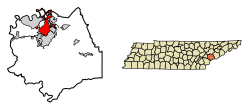Alcoa, Tennessee | |
|---|---|
 Alcoa Municipal Building | |
 Location of Alcoa in Blount County, Tennessee. | |
| Coordinates: 35°48′27″N83°58′31″W / 35.80750°N 83.97528°W | |
| Country | United States |
| State | Tennessee |
| County | Blount |
| Incorporated | 1919 |
| Named after | Aluminum Company of America |
| Area | |
• Total | 15.92 sq mi (41.22 km2) |
| • Land | 15.00 sq mi (38.85 km2) |
| • Water | 0.92 sq mi (2.37 km2) |
| Elevation | 932 ft (284 m) |
| Population | |
• Total | 10,978 |
| • Density | 731.82/sq mi (282.56/km2) |
| Time zone | UTC-5 (Eastern (EST)) |
| • Summer (DST) | UTC-4 (EDT) |
| Area code | 865 |
| FIPS code | 47-00540 [4] |
| GNIS feature ID | 2403075 [2] |
| Website | www |
Alcoa is a city in Blount County, Tennessee, United States. Its population was 10,978 at the 2020 census. [5] It is part of the Knoxville, TN Metropolitan Statistical Area.
Contents
- History
- Early company town
- The Great Depression and World War II
- Modern Alcoa
- Geography
- Climate
- Demographics
- 2020 census
- 2000 census
- Parks and recreation
- Education
- Infrastructure
- Major thoroughfares
- Notable people
- Government
- See also
- References
- External links
As its name suggests, Alcoa was the site of a large aluminum smelting plant owned and operated by the Alcoa corporation (Aluminum Company of America). Formerly known as North Maryville, the town was incorporated under its present name in 1919. [6]







